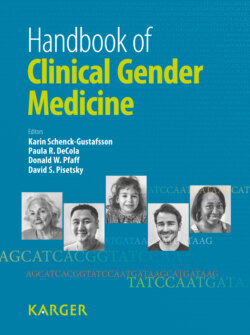Читать книгу Handbook of Clinical Gender Medicine - Группа авторов - Страница 55
На сайте Литреса книга снята с продажи.
Some Obstetrics Implications of Fetal Programming
ОглавлениеThroughout history, folklore wisdom has had it that experiences of the pregnant woman would affect the unborn child. Hippocrates, almost 2,500 years ago, wrote about how the emotional state of a pregnant woman would influence the outcome of pregnancy. The ancient Greeks believed that looking at beauty during pregnancy would lead to the delivery of a beautiful child and looking at ugliness would lead to an ugly child. Paul-Murphy [29], in her remarkable book, points to the fact that few obstetricians seek information on depression and stress in pregnant women in spite of the fact that maternal depression occurs at least as often as pregnancy-induced hypertension and 5-10 times as often as gestational diabetes, both of which are checked in the course of prenatal care. Williams Obstetrics [30] has been the leading English textbook for decades. The 18th edition was published in 1989 and lists 13 causes of preterm labor, including ‘unknown causes’. Maternal stress and depression are not addressed as causes of preterm labor. In the 23rd edition [31] of this textbook, published 21 years later, four main direct reasons are cited for preterm labor and an additional paragraph elaborates on 11 antecedent and contributing factors. Among these an association with depression, anxiety, and chronic stress is mentioned but without further elaboration. The 10th edition of Danforth’s Obstetrics and Gynecology [32], published in 2008, does not mention prenatal maternal stress as a risk factor for premature delivery. Clearly, modern obstetrics has not yet fully integrated the understanding of various aspects of fetal programming with crucial pathologies, like preterm labor and delivery. Throughout pregnancy, the fetus is exposed to exogenous stimuli and substances which reach him through his mother’s body and he is extremely sensitive to theses stimuli. The nutrition of his mother during pregnancy will affect his health throughout life and so does her mental state. The intrauterine environment may affect his future sexuality. The intrauterine milieu has a strong impact on the fetuses’ subsequent cognitive ability, and Devlin et al. [22] believe that the impact of intrauterine life on subsequent intelligence equals or exceeds the impact of education. To acknowledge the principle of fetal programming means to acknowledge the fundamental importance of intrauterine life on future health and disease. This will have a profound impact on the definition of future prenatal care. Patient education, avoidance of toxins, adequate maternal nutrition, and physical activity may positively affect and change the direction of fetal programming. All of these and many more aspects will expand the definition of prenatal care from caring for the pregnant women to a new concept of preventive medicine for adulthood diseases. If so much is at stake during the fateful months of pregnancy for future health and well-being, then adequate resources need to be directed toward adequate prenatal care. Of course, one caveat needs to be voiced. Fetal programming should not be confused with fetal determinism and does not mean that at delivery the destiny of the newborn has been decided upon and that what is left is to follow a predetermined path to wherever it leads. Education, the postnatal environment, awareness about possible risk factors, and the appropriate means to meet them leave much of our destiny in our hands and in the hands of society at large. Understanding the concept of fetal programming means also identifying potential risks and trying to avoid them and dealing with the risk factors once they have been identified. In China, the age of a baby at birth is 1 year, meaning that the first year of life is counted as one instead of zero. Fetal programming is a new science reflecting the importance of this particular and fateful year for the rest of our life.
